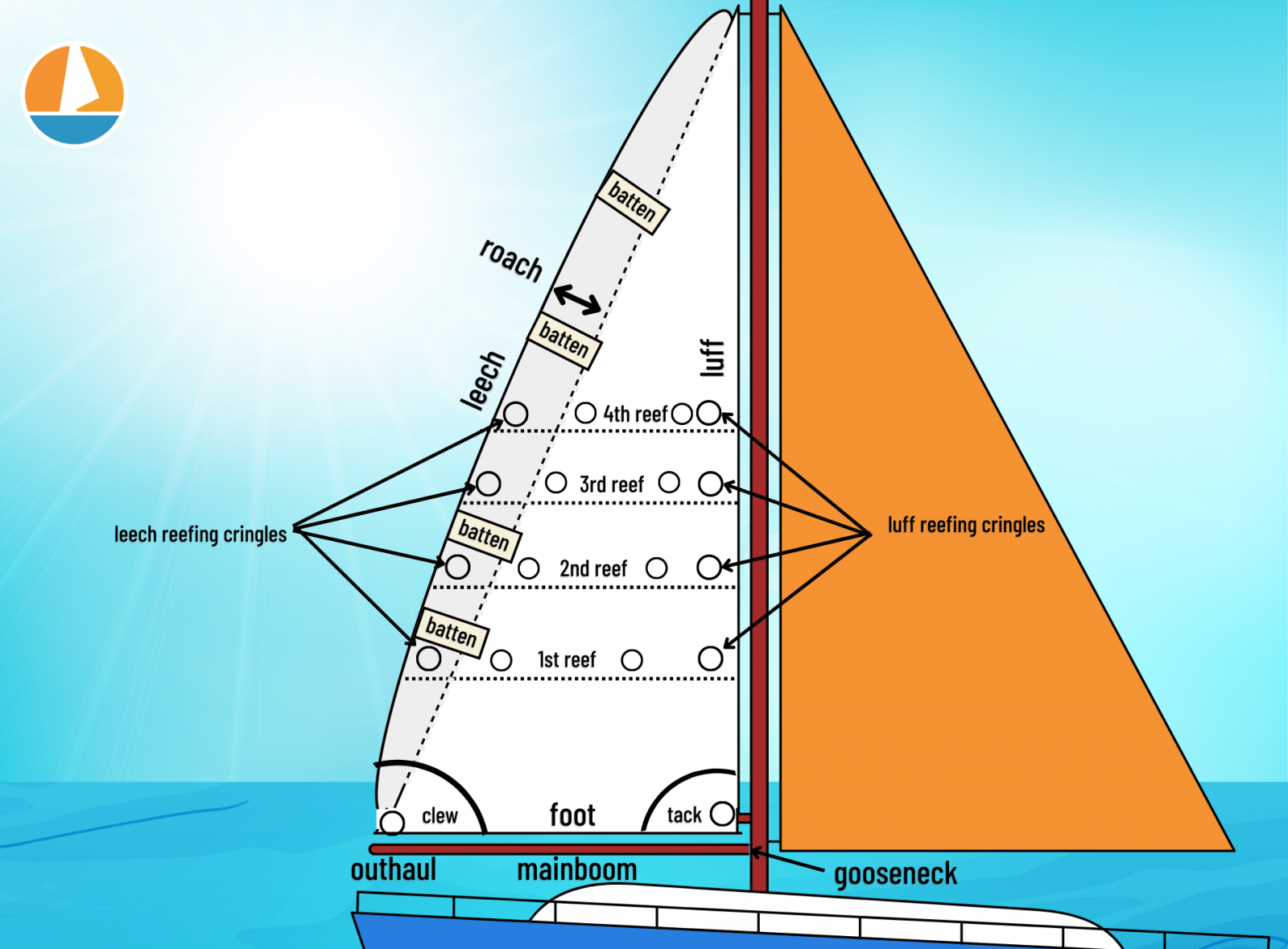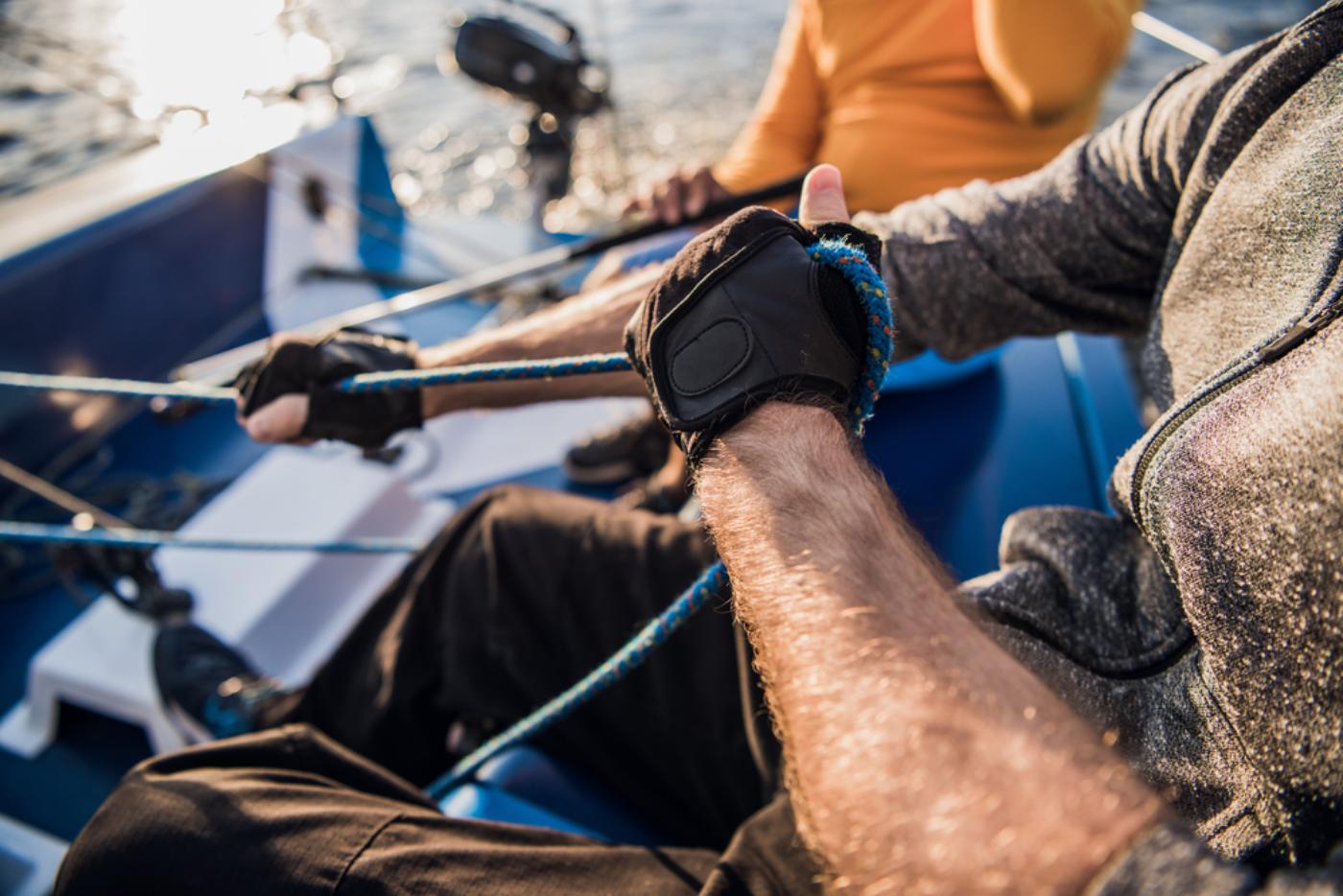How To Reef Your Sails (Mainsail, Jib, Furling, Loose)
Learning to reef your sails is a critical skill for on the water safety and enjoyable sailing. When the wind picks up, you want to know the best way to keep your boat under control, and reefing is your first response to building breeze.
What is reefing your sails? Reefing is reducing sail area in the sail without removing or dousing the sails. Depending on your boat, you can reef sails by partially furling them, or the halyard and tying them off. With reefed sails, your boat will be easier to handle in heavier weather.

Reefing is not hard to learn. An important part of how to reef is knowing when to reef. Also know that reefing is a normal strategy for sailing. It's not just a survival skill for extreme conditions, it's a skill that lets you sail better in heavy wind.
When Should You Reef a Sail?
Our rule for when to reef was when someone asks "do you think we should reef?" Meaning the first time the weather and wind build enough to give us some discomfort about the developing conditions, it was time to reef.
Because we had furling main and headsails, reefing was quick and easy for us so we reefed early. After all, you can always shake out the reef if conditions don't continue to deteriorate. You can't really reef too early. If you are uncomfortable with what you see happening on the water, reef the sails.
Reefing early when you're learning is smart because it takes time, especially if you have to leave the cockpit to do it. While you work, the wind may continue to build as conditions deteriorate, so the longer you wait the harder it may be to reef. You'll get faster as you do it more often, but when you're learning it's better to get an early start.
Specific signs that it may be time to reef:
- Sustained increase in wind speed, especially with large, powerful gusts.
- Out of control feeling to the boat that you can't ease by de-powering the sails.
- Storm/dark clouds on the horizon, especially in the direction you're sailing.
- Building wind-lashed waves and chop
Situational awareness when you are sailing into big breeze is critical. You don't want heavy wind to sneak up on you.
A reefed boat will sail well with a balanced helm, so get in the habit of reefing when you feel you're fighting the boat and the wind. Once you've mastered the skill you'll know when it's time, and you'll know when it's faster and more in control to reduce sail.

What Happens When You Reef?
The aim of reefing is to reduce the sail area that you expose to the wind. This lowers the forces on the boat, reduces heeling, and restores control to the helm and sail controls in overpowering conditions. You are reefing so you can keep sailing, but with more control and less power in the rig.
One downside to this is that you often lose some sail shape. Sails are cut to be flown full, but shortening sail can impact the efficiency. When you need to reef there's usually enough wind to keep the boat moving, even with a suboptimal shape that's harder to trim. The major performance impact is on upwind sailing. Without that nice headsail shape, you may not point as high.
You'll often find that sailing reefed is as fast as sailing with all your sails out, because the boat is in control and spends less time with the rail buried, rounding up, and sailing all over as you fight the rudder to keep the boat straight. And you'll be more comfortable.

How Do You Reef the Main Sail?
To reduce your main, you either furl it in if you can, or you drop the halyard to a set point and tie the main off on the boom with sail ties and reefing lines. The specifics vary with your rig, your equipment, and your boat and how you've set things up beforehand.
Reefing the main sail with jiffy or slab system
For boats without furling or sail handling systems, jiffy or slab reefing is the most common and easiest main reefing. You will need to leave the cockpit and work on deck to use most of these setups.
Your sails will have one or more reef points on them. Each reef point is a row of holes with grommets (called cringles) through the sails and parallel to the foot, with a larger hole on the luff and leach of the sail. Many boats will have a reef hook, a metal hook with the end facing the deck, on the boom or near the gooseneck. Reef lines are rigged through the large cringles on the leech and tie to the boom, with one line per leech cringle. Some sails may have tie-down lines at the cringles, but this is less common on newer sails since they add weight and drag. For most sails, you will also need sail ties - short lengths of line or web meshing - for each cringle between the leech and luff.
The basic process for most mainsails follows these steps. Follow this for any reef point on the sail.
- Sail upwind to center the main and take the load off. You can work with the main to the side, but it's more difficult.
- Snug up the topping lift (if needed) to keep the end of the boom from dropping.
- Ease the mainsheet and vang a little.
- Ease the main halyard until it's far enough to attach the luff cringle to the reefing hook (if there is one) or until it's at the boom if you need to tie it.
- Hook the luff cringle to the reefing hook, or tie it firmly to the boom with a sail tie.
- Pull the matching reef line down until the leech cringle is tight to the boom and tie it off.
- Gather the body of the sail into folds.
- Put a sail tie through each sail body cringle and around the boom and tie them off so the sail is tight against the boom.
- Snug the main halyard to add appropriate luff tension, ease the topping lift, and trim the vang.
The sail is now reefed, and you can sail normally and trim it again.
To "shake out the reefs" or unreef the sail, reverse the process. Ease the halyard, undo the ties, ease the reef line, undo the reef hook, and hoist the main halyard back up.
Reefing an in-mast furling main sail
In mast furling has a lot fewer steps, since you're just putting the main partially away. It’s like fully dousing the sail, but you only go partway and stop.
Most in mast furling systems have a way they like to be put away to avoid jams going in and out, and it's important that you keep this in mind when you reef. Our furler liked the boom centered and parallel to the deck, and a little tension on it as we furled. If we reefed with the boom way out over the side on a broad reach, we were taking our chances if we didn't shake the reefing out before we furled fully. We also eased the backstay before furling in or out normally, which isn't practical when the wind is hooting up.
As a good rule of thumb, always take the reef out of your main and stow it normally after you reef. Don't just keep furling the sail in if you've reefed with a different boom and sheet tension than usual, as you may end up jamming your sail.
So keep in mind how your furler works and what you need to do for smooth furling, and don't violate those guidelines as you do these steps.
- Head upwind to take tension off the main.
- Center the boom as much as is practical.
- Ease the outhaul as you furl the sail to reduce sail area. You may have to get a little ahead with the outhaul as you ease.
- Trim the outhaul properly after you finish furling.
That's all there is to it. To unreef, just ease the sail back out all the way while unfurling. If possible, do this without changing sheet or vang tension from when you reefed in, just to be sure the sail doesn't bind.
Reefing a boom-furling main sail
When boom furling, you'll need to ease the halyard as you furl the sail to the reefed position. Because the sail furls on the boom, the foot stays taught just like a slab reefed sail, but you don't need any lines to hold it.
Like main furling, if there are any specific steps you need to take like setting the boom height or position on the boat, take care to do as much of this as possible when you reef.
Different boom furling systems have different tolerances for furling and reefing at different wind angles. Some furlers do not work will furling off the wind, while others are fine on almost any point of sail. Consult your manual for your model boom furler for directions about furling and unfurling on different points of sail, and follow them when reefing.
- Head upwind to take tension off the main halyard.
- Ease the halyard to the desired height while furling the sail.
- Check halyard tension in case you got ahead furling.
Just raise the sail again to shake out the reef when the wind drops.
How Do You Reef the Headsail?
Headsail reefing is easier with roller furling, but hank on sails have a few challenges if they aren't set up for reefing.
Reefing a furling headsail
Like furling mainsails, reefing a furling headsail is just putting the sail partially away. Sine the sail isn't attached to the boom, it’s even easier. All you have to change are the jib cars.
To reef a furling headsail:
- Head upwind to take load off the sail.
- Furl the sail partway to the reefing point.
- Adjust jib cars forward for new sail length.
- Trim sail.
Removing the reef is just unfurling the sail and moving the jib cars back.
Reefing the headsail with hank-on sails
Most sailors with hank-on sails "reef" by swapping the headsail out for a smaller sail. But if a hank-on headsail has reef points, it may be less work to reef it then douse and bend on a new sail.
A jib rigged for reefing will have a cringle on the luff to attach near the deck, and a cringle at the leech for a second attachment point for the sheets. Note that most hanks are not strong enough to handle the load as the tack attachment point on the sail. You want a dedicated cringle with a sturdy grommet to attach the new tack point while reefed.
To reef a jib with a hank-on headstay:
- Head upwind to take load off the sail.
- Ease the jib halyard so the cringle in the reef point is near the deck.
- Attach the luff cringle to the reef hook or tie it to the base of the forestay.
- Move the sheets from the normal clew and tie them to the leech cringle, or use a second set of sheets if you have them.
- Bunch up the sail under the reefed areas as you can and tie with sail ties or bungees so it doesn't flap.
- Re-tension the halyard to the new position and trim the sail.
As you can see, there's going to be extra sail on the deck, which isn't as easy to contain without a boom to tie it to, and moving the sheet takes more work than main reefing.

Preparing Boats for Reefing
With no preparation, boats without furling systems cannot reef those sails at all. And if you have everything you need, if you don't prepare it in advance, reefing will be much more work.
Adding foam strips to furling sails
Furling headsails lose shape and get baggy when reefed, but a sail with foam strips to stiffen the luff keeps its shape better. It won't be perfect, but it will reef in a better shape with the support.
Getting hank on and track sails
For non-furling sails you will need:
- Reef points on the sails.
- Sail ties.
- Reef lines.
- A reefing hook is best, but you can tie the sail.
In addition, you'll need to run the reefing lines through the sail before you can reef. Where the reefing line runs to on your boat varies, but the far end of each line must go through the leech cringle for that reef point then down to the boom, where it ties with a bowline around the boom or to an installed block or ring.
Most sailors don't leave reefing lines rigged because they flop around and add drag to the sails. They aren't used often in fair weather sailing and many just don't go out when a big breeze is expected. But if there is wind in the forecast, take the time to rig one or more reef points so you don't have to do it in building seas and heavy wind.
Mark your main halyard for each reef point to save time and make it easier when you're dropping the halyard. Iit will get you close enough to get the job done before you do the final trim. Use a sharpie or put a few stitches of high visibility thread in the cover at each point.
Preparing for Various Reefing Scenarios
Reefing sails is the same on monohulls and catamarans, as it's the sail and rig you're worried about and the hulls have little to do with it. But other rigs and configurations beyond a sloop rig may require different or extra steps.
How you can reef when solo sailing
Reefing takes a lot of steps, and it's not always easy to do with one hand. Sailing by yourself, there won't be anyone to hold the wheel or ease lines as you haul others and tie things off.
For furling systems, the easiest way to reef with one hand (or person) is to do it step wise. As you head upwind, wase the outhaul (main) or sheet (headsail) a little, pull in the furler. Ease again, pull in again, until your sail is reefed where you want it. You can use the autopilot or your other hand to keep you on course.
For non-furling sails, single-line reefing systems can simplify the operation, as does running your reef lines, halyards, and topping lift to where you can reach them from all one place or with minimal movement.
Bring a single-line reefing kit
A single-line reefing system is a kit you install with several blocks and lines on the boom and mast to pull the tack and clew of a sail down together. It gets you out of hooking the luff cringle onto the reefing hook, since it pulls the luff down with the leech. If you need to tie down the middle of the sail, you still will need to move forward, but with the right setup, you can reef from the cockpit. It is more complex to install, but can be faster to use.
Did you find the answer to your specific question?
👍 0 👎 3
Leave a comment